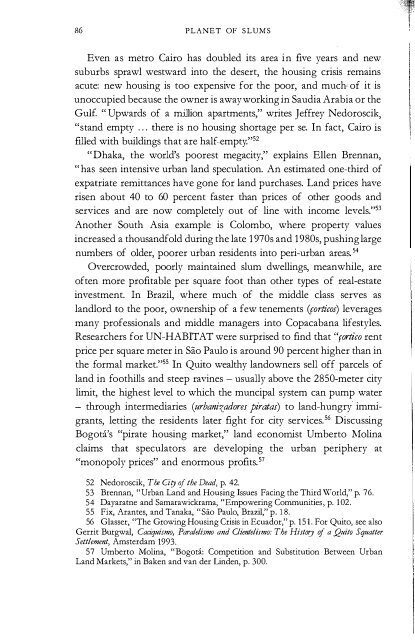Untitled - Rebel Studies Library
Untitled - Rebel Studies Library
Untitled - Rebel Studies Library
Create successful ePaper yourself
Turn your PDF publications into a flip-book with our unique Google optimized e-Paper software.
86 PLANET OF SLUMS<br />
Even as metro Cairo has doubled its area in five years and new<br />
suburbs sprawl westward into the desert, the housing crisis remains<br />
acute: new housing is too expensive for the poor, and much of it is<br />
unoccupied because the owner is away working in Saudia Arabia or the<br />
Gulf. "Upwards of a mjJlion apartments," writes Jeffrey Nedoroscik,<br />
"stand empty ... there is no housing shortage per se. In fact, Cairo is<br />
filled with buildings that are half-empty."52<br />
"Dhaka, the world's poorest megacity," explains Ellen Brennan,<br />
"has seen intensive urban land speculation. An estimated one-third of<br />
expatriate remittances have gone for land purchases. Land prices have<br />
risen about 40 to 60 percent faster than prices of other goods and<br />
services and are now completely out of line with income levels."53<br />
Another South Asia example is Colombo, where property values<br />
increased a thousandfold during the late 1970s and 1980s, pushing large<br />
numbers of older, poorer urban residents into peri-urban areas. 54<br />
Overcrowded, poorly maintained slum dwellings, meanwhile, are<br />
often more profitable per square foot than other types of real-estate<br />
investment. In Brazil, where much of the middle class serves as<br />
landlord to the poor, ownership of a few tenements (porticos) leverages<br />
many professionals and middle managers into Copacabana lifestyles.<br />
Researchers for UN-HABITAT were surprised to find that "portico rent<br />
price per square meter in Sao Paulo is around 90 percent higher than in<br />
the formal market."55 In Quito wealthy landowners sell off parcels of<br />
land in foothills and steep ravines - usually above the 2850-meter city<br />
limit, the highest level to which the muncipal system can pump water<br />
- through intermediaries (urbanizadores piratas) to land-hungry ' immigrants,<br />
letting the residents later fight for city services. 56 Discussing<br />
Bogota's "pirate housing market," land economist Umberto Molina<br />
claims that speculators are developing the urban periphery at<br />
"monopoly prices" and enormous profits. 57<br />
52 Nedoroscik, The City f the Dead, p. 42.<br />
53 Brennan, "Urban Land and Housing Issues Facing the Third \X'orld," p. 76.<br />
54 Dayaratne and Samarawickrama, "Empowering Communities, p. 102.<br />
55 Fix, Arantes, and Tanaka, "Sao Paulo, Brazil," p. 18.<br />
56 Glasser, "The Growing Housing Crisis in Ecuador," p. 151. For Quito, see also<br />
Gerrit Burgwal, Caciquismo, Paralelismo and Clientelismo: The Histmy 0/ a Quito Squatter<br />
Settlement, Amsterdam 1993.<br />
57 Umberto Molina, "Bogota: Competition and Substitution Between Urban<br />
Land Markets," in Baken and van der Linden, p. 300.<br />
ILLUSIONS OF SELF-HELP 87<br />
In her book on Lagos, Margaret Peil explains that "there has been<br />
much less squatting ... than in eastern Africa or Latin America because<br />
the low level of government control over construction meant that<br />
legitimate houses could be easily and profitably built: housing the poor<br />
was good business ... the safest investment available, producing a quick<br />
return on capital."58 Wealthier Lagos landlords prefer to lease rather<br />
than sell land so that they can retain control of profits in a rapidly<br />
appreciating land market. 59 As in Kenya, politicians, along with traditional<br />
chiefs, have been prominent amongst the larger-scale speculators<br />
in slum housing.60<br />
Nairobi's slums, meanwhile, are vast rent plantations owned by<br />
politicians and the upper middle class. Although most of the private<br />
rental development "has no formal legal basis ... property relations<br />
and ownership [thanks to a corrupt political system] exist in a de facto<br />
sense."61 In Mathare 4A, where 28,000 people - the poorest of the<br />
poor - rent 9-by-12-meter mud-and-wattle hovels, the absentee landlords,<br />
according to a researcher for the :Ministry of Roads, are<br />
"powerful, forceful behind the scenes and are often prominent public<br />
figures, those connected to them or very wealthy individuals or<br />
firms."62 "Fifty-seven percent of the dwellings in one Nairobi slum,"<br />
write UN researchers in another study, "are owned by politicians and<br />
civil servants, and the shacks are the most profitable housing in the city.<br />
A slumlord who pays $160 for a 100-square-foot shack can recoup the<br />
entire investment in months."63<br />
Land speculation, as these Nairobi cases illustrate, can thrive even<br />
where the land involved is officially in the public domain - Egypt,<br />
Pakistan, China and Mali offer other egregious examples. In metro<br />
Cairo, writes architect-planner Khaled Adham, "the selling-off of<br />
58 Margaret Peil, Lagos: The City Is the People, London 1991, p. 146.<br />
59 Margaret Peil, "Urban Housing and Services in Anglophone West Africa," in<br />
Hamish Main and Stephen Williams (eds), Environment and Housing in Third World Cities,<br />
Chichester 1994, p. 176.<br />
60 Drakakis-Smith, Third World Cities, p. 146.<br />
61 Amis, "Commercialized Rental Housing in Nairobi," p. 245.<br />
62 Patrick Wasike, "The Redevelopment of Large Informal Settlements in<br />
Nairobi," Ministry of Roads and Public Works, Kenya, nd.<br />
63 Cited in Davan Maharaj, "Living on Pennies," part four, Los Angeles Times, 16<br />
July 2004.


